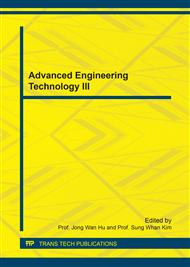p.295
p.301
p.306
p.313
p.320
p.325
p.331
p.336
p.341
Experimental Static Load Test of Prestressed Concrete Slab-on-Ground Model
Abstract:
This experimental static load test is part of research activities scoped on problematics with involved foundation conditions. Especially for areas with influence of undermining or flood hazard. Concept of experiment was designed like a model situation of interaction between concrete column, concrete slab-on-ground and subsoil. During static load process were measured deformations, tensions inside the experimental model and geotechnical values on contact surface of concrete slab-on-ground and subsoil. These data were processed and presented in this article. The described experimental static load test is part of a series of experiments focusing on the problematics of concrete constructions in interaction with subsoil and was realized at the Faculty of Civil Engineering, VŠB –Technical University of Ostrava.
Info:
Periodical:
Pages:
320-324
Citation:
Online since:
June 2017
Authors:
Price:
Сopyright:
© 2017 Trans Tech Publications Ltd. All Rights Reserved
Share:
Citation:


